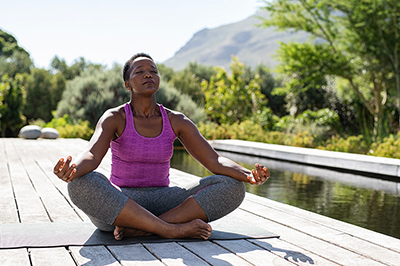Learn the best ways to manage pain without medication

Experiencing chronic pain is all too common. According to recent estimates, around 20 percent of the population, which equates to about 50 million Americans, suffer from chronic pain on a daily or weekly basis.
Chronic pain often goes mismanaged, according to Kelly Driscoll, BS, a behavioral health therapist at Mirmont Treatment Center, part of Main Line Health, focusing on addiction treatment. In the United States, people with chronic pain are frequently over-medicated or under-medicated to the point where the pain is not effectively managed.
Over time, people develop tolerance to many of the medications prescribed for pain. Some people may become addicted to these medications and others may turn to other drugs or substances to mask the pain.
The key to safely and effectively managing chronic pain is to find the dose or treatment plan that is appropriate for each patient. The more carefully and intentionally each person’s treatment plan is crafted, the lower their risk of developing an addiction. In addition to purposeful medication management, there are many non-pharmacological interventions that can not only relieve but improve pain.
Practicing meditation and yoga, for example, can build the mind-body relationship and help people get more in tune with their bodies. Hyperbaric oxygen chambers and biofeedback therapy are also among the best ways to manage pain without medication, by facilitating healing and promoting relaxation.
The key to success is to have an open mind that there are non-pharmacological techniques that will be able to alleviate your pain, says Driscoll. Managing chronic pain is a complicated and ever-changing process. There is no one-size-fits-all approach, and trying out different techniques is the best way to figure out what works for you.
Here are some ways to manage pain without medication:
Meditation to manage pain

Meditation is an easy yet powerful way to reduce stress and pain. Though the mechanisms aren’t clear, research has found that people who practice meditation experience pain reduction. During meditation, people learn how to manage their chronic pain without medication by learning how to sit with their pain, rather than fight it and try to change it.
Practicing meditation helps people acknowledge their pain and realize they are going to be okay. They won’t feel as strong of an urge to take something for the pain, but will instead learn how to be present with the pain. “It’s a whole different level of acceptance,” says Driscoll.
Hyperbaric oxygen chambers to manage pain

Use of hyperbaric oxygen chambers, the air pressure is significantly increased, which causes the lungs to suck in more oxygen than they would in a normal environment. This increased oxygenation throughout the body can have a profound impact on managing chronic pain without medication.
Hyperbaric oxygen chambers can help rejuvenate and detoxify the blood, ultimately strengthening the immune system. Evidence also shows that hyperbaric chambers can reduce inflammation and swelling in people with chronic pain.
“It speeds up the healing process of the injured tissues, ligaments, and bones,” explains Driscoll. “It will reduce scar tissue and prevent it from formation that causes a lot of damage for people and long-term pain issues.”
Biofeedback therapy to manage pain
Biofeedback is also one of the best ways to manage pain without medication. It is a technique used to help people understand their body functions—like heart rate, breathing, body temperature, and muscle contractions—and have better control over them.
Biofeedback involves various types of equipment that measure a person’s physiological functions and informs them how to use breathing and relaxation techniques to oxygenate their cells and facilitate healing.
Biofeedback helps with sleep and meditation. It can also give people the tools to better manage stress and feel more relaxed in their daily lives.
Acupuncture to manage pain
Acupuncture, a practice in which thin needles are inserted into the body, taps into the central nervous system and teaches it to relax.
It helps with relaxation techniques and detoxing, according to Driscoll.
Stretching, yoga, and physical therapy to manage pain

People with chronic pain tend to feel paralyzed by their pain and become sedentary. Over time, muscles can deteriorate, and pain symptoms can worsen. In an effort to protect their injury, people actually end up damaging muscles around their pain.
Because of this, physical therapy is one of the most effective techniques ways to manage pain without medication and provide targeted exercises that can strengthen your muscles and alleviate the pain.
Driscoll also recommends yoga, as the practice can help strengthen muscles and heal injuries.
Yoga can nourish the mind-body connection and help people gain awareness of what their bodies are telling them.
Have an open mind — these techniques work
When it comes to exploring ways to manage pain, the key to success is having an open mind. For some people, medications and drugs have become a coping skill. Though these medications may kick in quickly, they can also cause a significant amount of collateral damage to a person’s overall quality of life.
Techniques like meditation, acupuncture, and biofeedback have the ability to drastically improve the quality of life in people who experience chronic pain — not just in the short-term but the long-term as well.
There is no one-size-fits-all approach, and what works for one person will vary from what works for another. As people advance through recovery, they may need to change or adjust the techniques.
“Try different things in order to figure out what’s going to work for you. There is no one set plan,” Driscoll said.
For more information on how to manage pain without medication, call Mirmont at 1.888.CARE.898 (227.3898) to schedule a confidential appointment and ask any questions.
 Content you want, delivered to your inbox
Content you want, delivered to your inbox
Want to get the latest health and wellness articles delivered right to your inbox?
Subscribe to the Well Ahead Newsletter.
